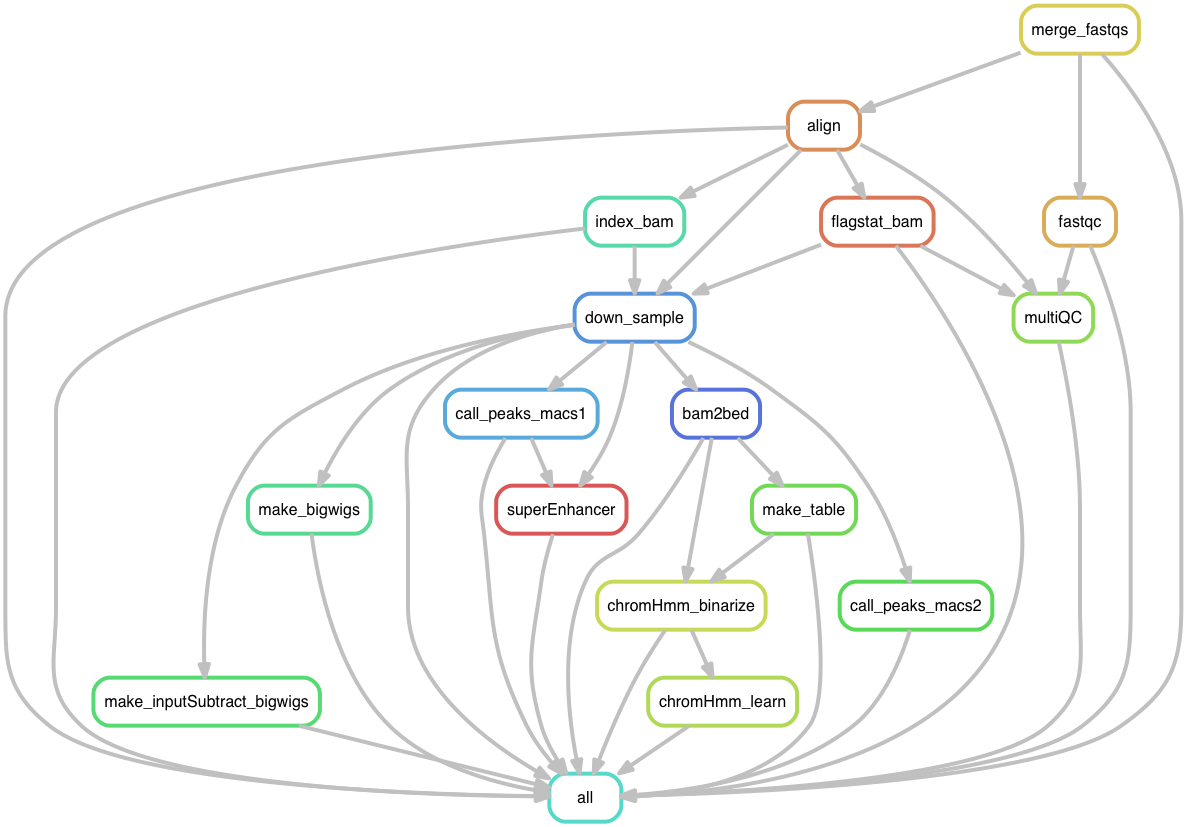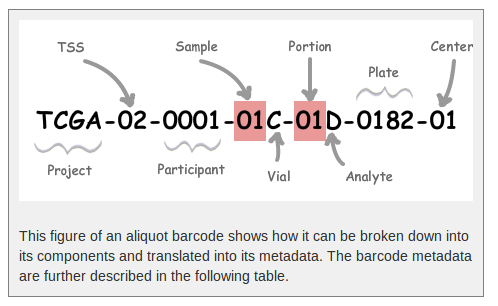a snakemake pipeline to process ChIP-seq files from GEO
I have so many people asking me to process a public GEO ChIP-seq data set for them. I hate to repeat the same steps and decide to make a pipeline for it.
switch to a different branch to see the codes. now I have shark branch for the LSF system.
UPDATE 05/30/2017. Now, the pipeline can handle in-house data as well.
Now, this is working on LSF, I will have another branch for Torque.
I created a doi on zenodo. You can cite:
In the config.yaml file you can change settings. e.g. path to a different genome to align, p value cut-offs. The target_reads is the number of reads that downsampled to. I set 15 million for default. If the number of reads of the orignal bam files are less than target_reads, the pipeline will just keep whatever the number it has.
- snakemake. snakemake is python3
- R > 3.3.0
you will need
optparsepackage.install.packages("optparse")SRAdb
source("https://bioconductor.org/biocLite.R")
biocLite("SRAdb") Rscript sraDownload.R -a ascp -QT -l 300m -i ~/.aspera/connect/etc/asperaweb_id_dsa.openssh -t fastq SRR3144652
This script will download the meta file for each SRR id as well.
- aspera for downloading
check this blog post by MARK ZIEMANN http://genomespot.blogspot.com/2015/05/download-sra-data-with-aspera-command.html
sh <(curl -s aspera-connect-3.6.2.117442-linux-64.sh)sraDownload.R is under the scripts folder from Luke Zappia:
## single quote your ascp command, otherwise R will be confused
Rscript sraDownload.R -a 'ascp -QT -l 300m -i ~/.aspera/connect/etc/asperaweb_id_dsa.openssh' -t fastq SRR3144652
- fastqc
bamCoveragev2.3.3 from deeptools for making RPKM normalized and input subtracted bigwig files- bowtie1 for aligning short reads (< 50bp)
- samblaster v0.1.22 to remove duplicates and downsampling.
- samtools v1.3.1
- ROSE for calling superEnhancer. ROSE has to be run inside the installation folder. now I hard coded the path in the Snakefile. (you will have to change that to the ROSE directory in your cluster). Todo: expose the path to the
config.yamlfile that one can change. - macs1 v1.4.2 and macs2 v2.1.1 for calling peaks (macs2 for broad peaks).
- multiQC
- phantompeakqual
macs1, macs2 and ROSE are python2.x, see this Using Snakemake and Macs2 in the snakemake google group.
if you look inside the Snakefile, I did source activate root back to python2.x before running macs1 and macs2.
There will be Integration of conda package management into Snakemake
read doc
ssh shark.mdanderson.org
# start a screen session
screen
# make a folder, name it yourself, I named it workdir for demon
mkdir /rsch2/genomic_med/krai/workdir/
cd /rsch2/genomic_med/krai/workdir/
git clone https://github.com/crazyhottommy/pyflow-ChIPseq
cd pyflow-ChIPseq
## go to downsampling branch. shark is LSF system
git checkout shark
## edit the config.yaml file as needed, e.g. set mouse or human for ref genome, p value cut off for peak calling, the number of reads you want to downsample to
nano config.yaml
## skip this if on Shark, samir has py351 set up for you. see below STEPS
conda create -n snakemake python=3 -c bioconda multiqc snakemake deeptools
source activate snakemakePrepare a txt file SRR.txt which has three columns: sample_name, fastq_name, and factor:
e.g.
cat SRR.txt
sample_name fastq_name factor
MOLM-14_DMSO1_5 SRR2518123 BRD4
MOLM-14_DMSO1_5 SRR2518124 Input
MOLM-14_DMSO2_6 SRR2518125 BRD4
MOLM-14_DMSO2_6 SRR2518126 Input
You can have mulitple different factors for the same sample_name.
sample_name_factor will be used to name the output. e.g. :MOLM-14_DMSO1_5_BRD4.sorted.bam
cd pyflow-ChIPseq
mkdir fastqs
cd fastqs
## fastq-dump only convert the sra files to fastq to the current folderrmake a shell script:
download.sh
download the sqlite database from http://dl.dropbox.com/u/51653511/SRAmetadb.sqlite.gz and unzip it. place it in the scripts folder
# /bin/bash
set -euo pipefail
## you will need to change the ascp command to get the right path
Rscript ../scripts/sraDownload.R -a 'ascp -QT -l 300m -i ~/.aspera/connect/etc/asperaweb_id_dsa.openssh' -d ../scripts/SRAmetadb.sqlite $1chmod u+x download.sh
# inside the pyflow-ChIPseq/fastq folder:
cat ../SRR.txt | sed '1d' | cut-f2 | sort | uniq > srr_unique.txt
## only have 4 jobs in parallel, good behavior on a cluster
cat srr_unique.txt | parallel -j 4 ./download.sh {}
# all the sra files will be downloaded in the current fastqs folder.Now you have all sra files downloaded into fastqs folder, proceed below:
## you can use a for loop to fastq-dump the downloaded sra files.
find *sra| parallel -j 4 fastq-dump {}
find *fastq | parallel -j 4 bgzip {}
## save some space
rm *sra
# go gack to the pyflow-ChIPseq folder
cd ..
python3 sample2json.py --fastq_dir fastqs/ --meta SRR.txtA samples.json file will be created and some information will be printed out on the screen.
## dry run
snakemake -np
## test for one sample
./pyflow-ChIPseq.sh 07bigwig/SRR2518123.bw
if no errors, preceed below.
Using DRMAA
DRMAA is only supported on Shark (LSF system).
module load drmma
./pyflow-drmaa-ChIPseq.shUsing drmaa can control + c to stop the current run.
Dependent jobs are submitted one by one, if some jobs failed, the pipeline will stop. Good for initital testing.
./pyflow-ChIPseq.shAll jobs will be submitted to the cluster on queue. This is useful if you know your jobs will succeed for most of them and the jobs are on queue to gain priority.
Different People have different naming conventions, to accomondate this situation, I require them to give me a meta.txt tab delimited file to have the sample information.
The sample2json.py script assumes that the fastq_name in the meta.txt file exist in the fastq files. Only the first three columns will be used.
factors from the same sample_name will be made into one group.
set the control in the config.ymal file, which you are going to use for peak calling. e.g. Input, IgG
cd pyflow-ChIPseq
cat meta.txt
sample_name fastq_name factor reference
sample1 Li-Lane-1-1A-062817 CST-CHD1 mouse
sample1 Li-Lane-1-1C-062817 Bethal-CHD1 mouse
sample1 Li-Lane-1-1E-062817 IgG mouse
sample1 Li-Lane-4-7E-062817 Input mouse
sample2 Li-Lane-1-1B-062817 CST-CHD1 mouse
sample2 Li-Lane-1-1D-062817 Bethal-CHD1 mouse
sample2 Li-Lane-1-1F-062817 IgG mouse
sample2 Li-Lane-4-7F-062817 Input mouse
sample3 Li-Lane-2-3C-062817 SOX2 mouse
sample3 Li-Lane-2-3D-062817 H3K27Ac mouse
sample3 Li-Lane-4-7G-062817 Input mouse
sample4 Li-Lane-2-3E-062817 H3K9me3 mouse
sample4 Li-Lane-3-5A-062817 H3K27Ac mouse
sample4 Li-Lane-3-5E-062817 MYC mouse
sample4 Li-Lane-2-7H-062817 Input mouse
sample5 Li-Lane-2-3F-062817 H3K9me3 mouse
sample5 Li-Lane-3-5B-062817 H3K27Ac mouse
sample5 Li-Lane-3-9A-062817 Input mouse
sample6 Li-Lane-2-3G-062817 H3K9me3 mouse
sample6 Li-Lane-3-5C-062817 H3K27Ac mouse
sample6 Li-Lane-4-9B-062817 Input mouse
sample7 Li-Lane-2-3H-062817 H3K9me3 mouse
sample7 Li-Lane-3-5D-062817 H3K27Ac mouse
sample7 Li-Lane-3-5H-062817 MYC mouse
sample7 Li-Lane-4-9C-062817 Input mouse
## only the first 3 columns are required.
## make a samples.json file
python3 sample2json.py --fastq_dir dir/to/fastqs/ --meta meta.txtThe real name of the fastq files:
/rsrch2/genomic_med/krai/zheng-ChIPseq-2/Sample_Li-Lane-1-1C-062817/Li-Lane-1-1C-062817_S24_L004_R1_001.fastq.gz
check the example samples.json file in the repo.
Now, the same as the steps as processing the sra files
# dry run
pyflow-ChIPseq.sh -npIf one sets up a lab, it is necessary to have consistent file naming across all the projects. TCGAproject is a great example for us to follow. A barcode system can make your life a lot easier for downstream analysis.
Similarily, for a ChIP-seq project, it is important to have consistent naming. In Dr.Kunal Rai'lab. We adopted a barcoding system similar to TCGA:
e.g.
TCGA-SKCM-M028-11-P008-A-NC-CJT-T
TCGA is the big project name;
SKCM is the tumor name;
M028 is the sample name (this should be an unique identifier);
11 is the sequencing tag;
we use 11 to denote first time IP, first time sequencing, if the reads number is too few, but the IP worked, we just need to resequence the same library. for the resequencing sample, we will use 12 for this. if the total reads number is still too low, 13 could be used. 21 will be second time IP and first time sequencing. etc.
P008 is the plate number of that IP experiment, we now use 96-well plate for ChIP-seq, we use this id to track which plate the samples are from.
A is the chromatin mark name or transcription factor name. we have a naming map for this:
A is H3K4me1, B is H3K9me3 and G is for Input etc.
The other barcode areas can be used for other information. NC means the samples were sequenced in north campus.
It saves me a lot in the downstream processing. The barcode can be captured by a universal regular expression from the fastq.gz files.
A real experiment comes a fastq.gz name like this
TCGA-SKCM-M028-R1-P008-C-NC-CJT-T_TTAGGC_L001_R1_006.fastq.gz
multiplexing is very common nowadays, the sequencing reads for the same sample may come from different lanes, after de-multiplexing, multiple files for the same sample will be put in the same folder. If you name your files in a consistent way, you can easily merge all the fastq files before mapping. (for DNA sequencing, it is recommended to map the fastq files independently and then merge the mapped bam files with read-group to identify which lane it is from).
It also helps for merging the fastq files from two different rounds of sequencing. I know sequencing tag 11 and 12 with the same sample name and chromatin mark name are for the same sample, so I can merge them together programatically.
I also know that G is a Input control sample, I can then call peaks, make Input subtracted bigwigs etc using a IP vs Input pattern. (A_vs_G, B_vs_G). Same idea can be used for tumor and control for whole genome sequencing when calling mutations and copynumber.
Many other people out of our lab let me process their data, I can not enforce naming of the files before they carry out the experiments. That's why I require them to give me a meta.txt file instead.
To kill all of your pending jobs you can use the command:
bkill `bjobs -u krai |grep PEND |cut -f1 -d" "`other useful commands:
bjobs -pl
Display detailed information of all pending jobs of the invoker.
bjobs -ps
Display only pending and suspended jobs.
bjobs -u all -a
Display all jobs of all users.
bjobs -d -q short -m apple -u mtang1
Display all the recently finished jobs submitted by john to the
queue short, and executed on the host apple.
# specify the name of the rule, all files that associated with that rule will be rerun. e.g. rerun macs2 calling peaks rule,
./pyflow-ChIPseq -R call_peaks_macs2
## rerun one sample, just specify the name of the target file
./pyflow-ChIPseq -R 02aln/SRR3144652.sorted.bam
# check snakemake -f, -R, --until options
./pyflow-ChIPseq -f call_peaks_macs2snakemake --summary | sort -k1,1 | less -S
# or detailed summary will give you the commands used to generated the output and what input is used
snakemake --detailed-summary | sort -k1,1 > snakemake_run_summary.txtI use echo to see what will be removed first, then you can remove all later.
find . -maxdepth 1 -type d -name "[0-9]*" | xargs echo rm -rf
Snakemake has a kind of “lazy” policy about added input files if their modification date is older than that of the output files. One reason is that information what to do cannot be inferred just from the input and output files. You need additional information about the last run to be stored. Since behaviour would be inconsistent between cases where that information is available and where it is not, this functionality has been encoded as an extra switch. To trigger updates for jobs with changed input files, you can use the command line argument –list-input-changes in the following way:
snakemake -n -R `snakemake --list-input-changes`
snakemake -n -R `snakemake --list-params-changes`and
snakemake -n -R `snakemake --list-code-changes`provide a output directory now everything will be output in the current pyflow-ChIPseq directory in a structured fasion. : 00log, 01seq, 02fqc, 03aln etc
work for paired-end ChIPseq as well now only for single-end.
put everything in docker

